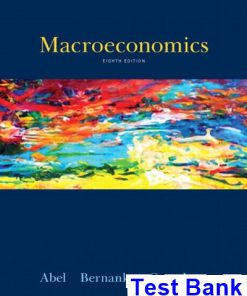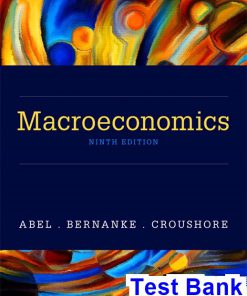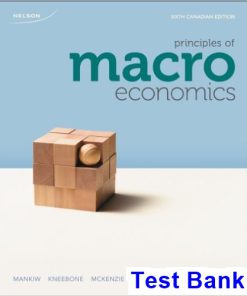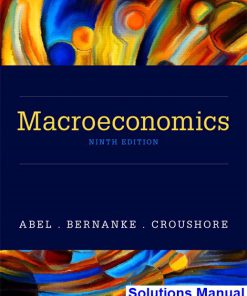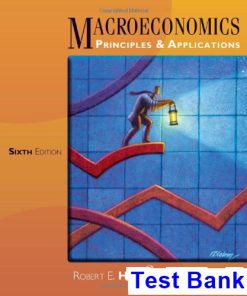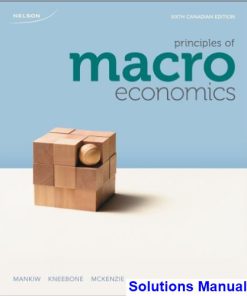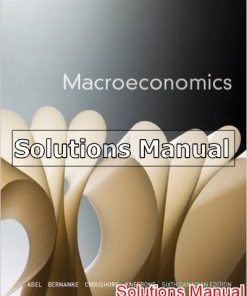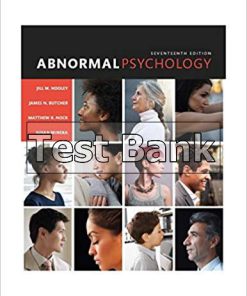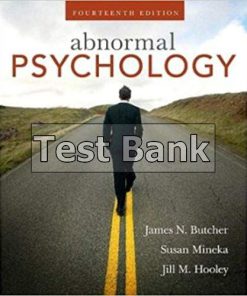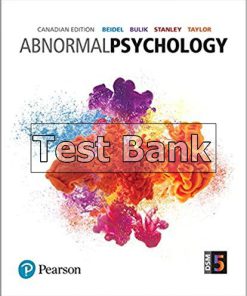Macroeconomics Canadian 6th Edition Abel Test Bank
$50.00 Original price was: $50.00.$26.50Current price is: $26.50.
Macroeconomics Canadian 6th Edition Abel Test Bank.
Macroeconomics Canadian 6th Edition Abel Test Bank

Product details:
- Hardcover : 656 pages
- ISBN-10 : 0321675606
- ISBN-13 : 978-0321675606
- Author: Andrew B. Abel
Praised in its previous editions for giving students the tools they need to think critically and coherently about macroeconomics, Macroeconomics, Sixth Canadian Edition, has been revised to include new material to keep the text modern and up to date, while building on the strengths that underlie the book’s lasting appeal.
Table contents:
- Part 1 Introduction and Measurement Issues
- Chapter 1 Introduction
- Introduction
- What Is Macroeconomics?
- Gross Domestic Product, Economic Growth, and Business Cycles
- Macroeconomic Models
- Microeconomic Principles
- Disagreement in Macroeconomics
- What Do We Learn from Macroeconomic Analysis?
- Understanding Recent and Current Macroeconomic Events
- Government Spending and the Government Surplus
- Unemployment
- Inflation
- Interest Rates
- Trade and the Current Account Surplus
- Business Cycles
- Chapter Resources
- Questions for Review
- Problems
- Chapter 2 Measurement
- Introduction: Measurement
- Measuring GDP: The National Income and Expenditure Accounts
- The Product Approach to Measuring GDP
- The Expenditure Approach
- The Income Approach
- An Example with Inventory Investment
- An Example with International Trade
- What Does GDP Leave Out?
- The Components of Aggregate Expenditure
- Nominal and Real GDP and Price Indices
- Measures of the Price Level
- Problems with Measuring Real GDP and the Price Level
- Savings, Wealth, and Capital
- Labour Market Measurement
- Chapter Resources
- Questions for Review
- Problems
- Chapter 3 Business Cycle Measurement
- Introduction: Business Cycle Measurement
- Regularities in GDP Fluctuations
- Comovement
- The Components of GDP
- The Price Level and Inflation
- Labour Market Variables
- Comovement Summary
- Chapter Resources
- Questions for Review
- Problems
- Part 2 Basic Macroeconomic Models: A One-Period Model, and Models of Search and Unemployment
- Chapter 4 Consumer and Firm Behaviour: The Work–Leisure Decision and Profit Maximization
- Introduction: Consumer and Firm Behaviour: The Work–Leisure Decision and Profit Maximization
- The Representative Consumer
- The Representative Consumer’s Budget Constraint
- The Budget Constraint
- Consumer Optimization
- How Does the Representative Consumer Respond to a Change in Real Dividends or Taxes?
- The Representative Consumer and Changes in the Real Wage: Income and Substitution Effects
- An Example: Consumption and Leisure are Perfect Complements
- The Representative Firm
- The Effect of a Change in Total Factor Productivity on the Production Function
- The Profit Maximization Problem of the Representative Firm
- Chapter Resources
- Questions for Review
- Problems
- Chapter 5 A Closed-Economy One-Period Macroeconomic Model
- Introduction: A Closed-Economy One-Period Macroeconomic Model
- Government
- Competitive Equilibrium
- Optimality
- Sources of Social Inefficiencies
- How to Use the Model
- Working with the Model: The Effects of a Change in Government Purchases
- Working with the Model: A Change in Total Factor Productivity
- Interpretation of the Model’s Predictions
- A Distorting Tax on Wage Income, Tax Rate Changes, and the Laffer Curve
- Income Tax Revenue and the Laffer Curve
- Keynesian Sticky Wages and Prices
- Chapter Resources
- Questions for Review
- Problems
- Chapter 6 Search and Unemployment
- Introduction: Search and Unemployment
- The Behaviour of the Unemployment Rate, the Participation Rate, and the Employment/Population Ratio in Canada
- A One-Sided Search Model of Unemployment
- The Welfare of Employed and Unemployed Workers
- The Reservation Wage
- The Determination of the Unemployment Rate
- An Increase in Employment Insurance Benefits
- A Two-Sided Search Model of Unemployment and Labour Market Participation
- Consumers
- Firms
- Matching
- Optimization by Consumers
- Optimization by Firms
- Equilibrium
- An Increase in the Employment Insurance Benefit
- An Increase in Productivity
- A Decrease in Matching Efficiency
- Chapter Resources
- Questions for Review
- Problems
- Part 3 Economic Growth
- Chapter 7 Economic Growth: Malthus and Solow
- Introduction: Economic Growth: Malthus and Solow
- Economic Growth Facts
- The Malthusian Model of Economic Growth
- Analysis of the Steady State in the Malthusian Model
- The Effects of an Increase in z on the Steady State
- How Useful is the Malthusian Model of Economic Growth?
- The Solow Model: Exogenous Growth
- The Representative Firm
- Competitive Equilibrium
- Analysis of the Steady State
- The Steady-State Effects of an Increase in the Savings Rate
- Consumption per Worker and Golden Rule Capital Accumulation
- The Steady-State Effects of an Increase in Labour Force Growth
- Growth and the Distribution of Income
- Growth Accounting
- Solow Residuals and Productivity Slowdowns
- A Growth Accounting Exercise
- Chapter Resources
- Questions for Review
- Problems
- Chapter 8 Income Disparity among Countries and Endogenous Growth
- Introduction: Income Disparity among Countries and Endogenous Growth
- Convergence
- Endogenous Growth: A Model of Human Capital Accumulation
- The Representative Consumer
- The Representative Firm
- Competitive Equilibrium
- Economic Policy and Growth
- Convergence in the Endogenous Growth Model
- Endogenous Growth and the Distribution of Income
- Chapter Resources
- Questions for Review
- Problems
- Part 4 Savings, Investment, and Government Deficits
- Chapter 9 A Two-Period Model: The Consumption–Savings Decision and Credit Markets
- Introduction: A Two-Period Model: The Consumption–Savings Decision and Credit Markets
- A Two-Period Model of the Economy
- Consumers
- The Consumer’s Lifetime Budget Constraint
- The Consumer’s Preferences
- Consumer Optimization
- An Increase in Current-Period Income
- An Increase in Future Income
- Temporary and Permanent Changes in Income
- An Increase in the Real Interest Rate
- An Example: Perfect Complements
- Government
- Competitive Equilibrium
- The Ricardian Equivalence Theorem
- Ricardian Equivalence: A Numerical Example
- Ricardian Equivalence: A Graph
- Ricardian Equivalence and Credit Market Equilibrium
- Ricardian Equivalence and the Burden of the Government Debt
- Chapter Resources
- Questions for Review
- Problems
- Chapter 10 Credit Market Imperfections: Credit Frictions, Financial Crises, and Social Security
- Introduction: Credit Market Imperfections: Credit Frictions, Financial Crises, and Social Security
- Credit Market Imperfections and Consumption
- Example: Credit Market Imperfections in General Equilibrium
- Asymmetric Information and Financial Crises
- Limited Commitment and Financial Crises
- Ricardian Equivalence, Intergenerational Redistribution, and Social Security
- Pay-as-You-Go Social Security
- Fully Funded Social Security
- Chapter Resources
- Questions for Review
- Problems
- Chapter 11 A Real Intertemporal Model with Investment
- Introduction: A Real Intertemporal Model with Investment
- The Representative Consumer
- Current Labour Supply
- The Current Demand for Consumption Goods
- The Representative Firm
- Profits and Current Labour Demand
- The Representative Firm’s Investment Decision
- Optimal Investment: A Numerical Example
- Investment with Asymmetric Information: The Financial Crisis
- Government
- Competitive Equilibrium
- The Current Labour Market and the Output Supply Curve
- Shifts in the Output Supply Curve
- The Current Goods Market and the Output Demand Curve
- Shifts in the Output Demand Curve
- The Complete Real Intertemporal Model
- The Equilibrium Effects of a Temporary Increase in G: Stimulus, the Multiplier, and Crowding Out
- The Equilibrium Effects of a Decrease in the Current Capital Stock, K: Capital Destruction from Wars and Natural Disasters
- The Equilibrium Effects of an Increase in Current Total Factor Productivity, z
- The Equilibrium Effects of an Increase in Future Total Factor Productivity, z′: News about the Future and Aggregate Economic Activity
- Housing Market Bubbles and Aggregate Activity
- Chapter Resources
- Questions for Review
- Problems
- Part 5 Money and Business Cycles
- Chapter 12 A Monetary Intertemporal Model: Money, Banking, Prices, and Monetary Policy
- Introduction: A Monetary Intertemporal Model: Money, Banking, Prices, and Monetary Policy
- What Is Money?
- Monetary Intertemporal Model
- Real and Nominal Interest Rates and the Fisher Relation
- Banks and Alternative Means of Payment
- Equilibrium in the Market for Credit Card Services and the Demand for Money
- Government
- Competitive Equilibrium—The Complete Intertemporal Monetary Model
- A Level Increase in the Money Supply and Monetary Neutrality
- Shifts in Money Demand
- Conventional Monetary Policy, the Liquidity Trap, and Unconventional Monetary Policy
- Quantitative Easing
- Negative Nominal Interest Rates
- Corridor Systems and Floor Systems
- Chapter Resources
- Questions for Review
- Problems
- Chapter 13 Business Cycles
- Introduction: Business Cycles
- The Real Business Cycle Model
- Real Business Cycles and the Behaviour of Nominal Variables
- Implications of Real Business Cycle Theory for Government Policy
- Critique of Real Business Cycle Theory
- The New Keynesian Model
- The Non-Neutrality of Money in the New Keynesian Model
- The Role of Government Policy in the New Keynesian Model
- Does the New Keynesian Model Replicate the Data?
- The Liquidity Trap and Sticky Prices
- Criticisms of Keynesian Models
- Chapter Resources
- Questions for Review
- Problems
- Chapter 14 Inflation: Phillips Curves and Neo-Fisherism
- Introduction: Inflation: Phillips Curves and Neo-Fisherism
- Inflation in a Basic New Keynesian Model
- Monetary Policy Goals
- Low Real Interest Rates and the Zero Lower Bound
- Neo-Fisherism and a New Keynesian Rational Expectations Model
- Neo-Fisherism and Taylor Rules
- Chapter Resources
- Questions for Review
- Problems
- Part 6 International Macroeconomics
- Chapter 15 International Trade in Goods and Assets
- Introduction: International Trade in Goods and Assets
- A Two-Period Small Open-Economy Model
- Credit Market Imperfections and Default
- Production, Investment, and the Current Account
- The Effects of an Increase in the World Real Interest Rate
- A Temporary Increase in Government Expenditure and the Effects on the Current Account and Domestic Output
- The Effects of Increases in Current and Future Total Factor Productivity
- Current Account Deficits, Consumption, and Investment
- Tariff Barriers
- Chapter Resources
- Questions for Review
- Problems
- Chapter 16 Money in the Open Economy
- Introduction: Money in the Open Economy
- The Nominal Exchange Rate, the Real Exchange Rate, and Purchasing Power Parity
- Flexible and Fixed Exchange Rates
- A Monetary Small Open-Economy Model with a Flexible Exchange Rate
- The Neutrality of Money with a Flexible Exchange Rate
- A Nominal Shock to the Domestic Economy from Abroad: P* Increases
- A Real Shock to the Domestic Economy from Abroad
- A Monetary Small Open-Economy Model with a Fixed Exchange Rate
- A Nominal Foreign Shock Under a Fixed Exchange Rate
- A Real Foreign Shock Under a Fixed Exchange Rate
- Exchange Rate Devaluation
- Flexible versus Fixed Exchange Rates
- Capital Controls
- The Effects of Capital Controls
- A New Keynesian Sticky Price Open-Economy Model
- Monetary Policy in the New Keynesian Model with a Flexible Exchange Rate
- Fiscal Policy
- Fixed Exchange Rate
- Tariff Wars and Short Run Macroeconomic Activity
- Chapter Resources
- Questions for Review
- Problems
- Part 7 Money, Inflation, and Banking
- Chapter 17 Money and Inflation: A Deeper Look
- Introduction: Money and Inflation: A Deeper Look
- Alternative Forms of Money
- Money and the Absence of Double Coincidence of Wants: The Roles of Commodity Money and Fiat Money
- Anticipated Inflation and the Friedman Rule: A Lagos-Wright Monetary Model
- Pareto-Optimal Allocation
- Equilibrium in the Lagos-Wright Model
- Optimal Monetary Policy: The Friedman Rule
- Chapter Resources
- Questions for Review
- Problems
- Chapter 18 Financial Intermediation and Banking
- Introduction: Financial Intermediation and Banking
- Properties of Assets
- Financial Intermediation
- The Diamond-Dybvig Banking Model
- A Diamond-Dybvig Bank
- Bank Runs in the Diamond-Dybvig Model
- Deposit Insurance
- Chapter Resources
- Questions for Review
- Problems
- Mathematical Appendix
- Introduction: Mathematical Appendix
- Chapter 5: A Closed-Economy One-Period Macroeconomic Model
- Chapter 6: Search and Unemployment
- Chapters 7 and 8: Economic Growth
- Chapter 9: Two-Period Model
- Chapter 11: A Real Intertemporal Model with Investment
- Chapter 12: A Monetary Intertemporal Model
- Chapter 17: Money and Inflation: A Deeper Look
- Chapter 18: Financial Intermediation and Banking
- Notation Appendix
- Glossary
People also search:
Macroeconomics Canadian 6th
Macroeconomics Canadian 6th pdf free
Macroeconomics Canadian 6th pdf
Macroeconomics Canadian 6th download scribd
Macroeconomics Canadian 6th full pdf version
Instant download after Payment is complete
You may also like…
Canadian
Principles of Macroeconomics Sixth Canadian Edition Canadian 6th Edition Mankiw Solutions Manual




